It is an article of faith in climate science that the temperature of the stratosphere is due to the impact of short wave radiation. This is incorrect. In fact the temperature of the stratosphere is due to the interception of long wave radiation from the Earth by ozone. It is another article of faith that the circulation of the air is driven from the tropics. This is also incorrect.
The temperature of the atmosphere reflects many forces at work but the most important of these so far as the circulation of the air is concerned is ozone. The ozonosphere can be considered to extend from the surface of the planet through to the mesopause. The shape of the ozonosphere is a product of a number of forces:
- The interaction of short wave solar radiation with the atmosphere that supplies oxygen in atomic form to combine with O2 to form O3. This occurs in the mesosphere down to about 60 km in elevation and also it seems at the poles where cosmic rays ionise the atmosphere allowing the formation of ozone.
- The tropical atmosphere below about 40 kilometres in elevation exhibits an increase in its ozone content in daylight hours and may be considered a relatively safe zone where ozone can accumulate in trace amounts.
- Relief from the pressure of ionisation at low sun angles. Ozone is ionised by UVB and shorter wave lengths that are used up in the process. Because the atmospheric path is long very little ultraviolet B reaches the polar regions to destroy ozone and none at all during the period of the polar night.
- The lower profile of the stratosphere is sculpted by the erosive activity of NOx that is influential in establishing the height of the tropopause and in the process determines the elevation where the maximum in ozone partial pressure occurs.
- At the poles the intake of mesospheric air varies on all time scales and regulates ozone partial pressure accordingly.
The ozone content of the air and the height of the troposphere so established are influential in determining surface pressure and therefore the flow of the air, in fact the location and intensity of the planetary winds that regulate the equator to pole temperature gradient and the extent and location of cloud cover that limits the incidence of solar radiation at the surface.
To examine the profile of the stratosphere at all latitudes would be a worthy but onerous task that I will leave to others. But it is instructive to study the temperature of the atmosphere in a particular latitude band to try and discern the forces at work because they are different according to hemisphere and latitude. I look in particular at the temperature of the air in the latitude band 30-40° south at selected levels starting at the planets skin, then 2 metres above the surface, at 700 hPa, at 500 hPa where half the atmosphere is below and half above, 300 hPa where something quite strange begins to happen, at 200 hPa and 100 hPa where paradoxically the air is warmer in winter than in summer. Then we look at the temperature of the air at 30 Mb and at 10 Mb therefore spanning 99% of the depth of the atmosphere. This site is the starting point: http://www.esrl.noaa.gov/psd/map/time_plot/
A SURVEY OF THE ATMOSPHERIC PROFILE AT 30-40° SOUTH LATITUDE.
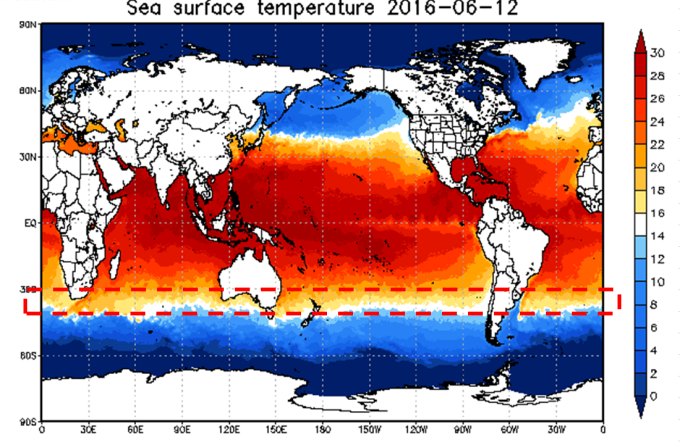
The map above shows the latitude band under investigation. It is mostly sea.
The hovmoller diagram below shows the average temperature at the surface across the 30-40° south latitude band as it evolves in the interval of the single year 2014. There is nothing special about this year. Any year would do.
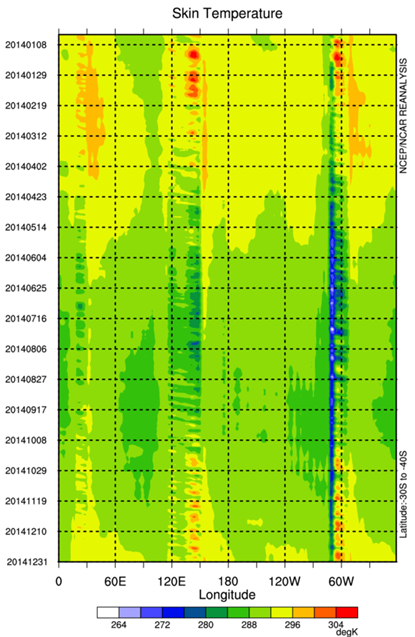
The skin temperature exhibits a pattern of summer warming influenced by the location of the land masses of South Africa, Australia-New Zealand and South America. There is marked warming of the Pacific Ocean from November through to June. There are southward moving warm currents on the west of the ocean basins and up welling of cold waters on the east of the basins particularly to the west of South America. Also seen is the remarkably episodic pattern in the cooling of the Australian continent in winter that relates to an intermittent flow of cold air that traverses the continent from north west to south east. The Pacific maintains a zone of relative warmth to the east of the Australian continent perhaps by virtue of the relative width of the ocean and the strength of the southerly trending circulation of warm waters from the tropics.The land masses warm strongly in summer.Notice the strong cooling of the Indian Ocean to the west of Australia in winter-spring that tends to promote the formation of a sticky zone of high atmospheric pressure. In contrast the warmth of the Pacific in the vicinity of New Zealand creates s sticky zone of low surface pressure.
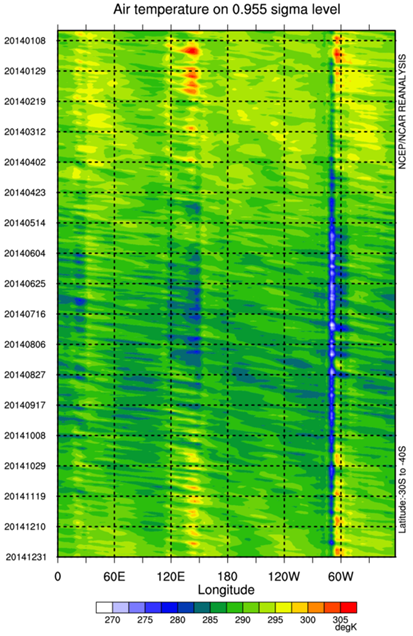
The proposition advanced in climate science is that the temperature of the air predominantly reflects the temperature of the skin. Above we see that even at 2 metres of elevation this is not the case. Already warming and cooling is intermittent within a season by comparison with skin temperature. The scale necessary to span the variation in the temperature of the skin spans 48°C. The scale required at 2 metres is only 4o° C. The land masses cool the air in winter while air over the sea remains warmer. Texture in the temperature data is produced by moving air bodies that originate in the north west (called the westerlies) that locate towards the south east at a later date reflecting the fact that the atmosphere rotates faster than the Earth itself and propagates towards the south east carrying tropical warmth to higher latitudes but in an intermittent fashion.The warm air is also wet and arrives with cloud. The presence of cloud can be erroneously considered to be the source of the warmth via back radiation whereas the air is actually warm because of its origin. In fact any particular location on the Earths surface will be warm or cool according to the origin of the air. If the air changes in either its speed or direction this alters the equator to pole temperature gradient.
The ultimate fate of the air in these latitudes is to be drawn into a low pressure cyclone located at 50-70° south latitude. We see that the pattern made by the north westerlies is more defined in winter and spring than in summer and autumn. Autumn is a pleasant time of the year in some of the windiest latitudes on the planet. By latitude as we move southwards from the thirties we have the Roaring Forties, the Furious Fifties and the Screaming Sixties. In winter the Thirties assume some of the character of the Forties.
Warmer air manifests in shorter strings with less persistence probably because it is rising and leaving the cold air at the surface in long remnant streamers. Cold air, locally chilled as it travels over cold water pools into the valleys of Andes mountains in winter. There is a clearer definition of summer and winter in the temperature at 2 metres than in skin temperature. We see that the atmosphere heavily influences near surface air temperature regardless of the status of skin temperature. Temperature is not simply a function of the angle of the sun. Cloud cover plays a part in determining local air temperature. Not shown is precipitation rates and relative humidity that exhibit the same north west to south east streaming. The Pacific sector to the East of 150° east longitude is wetter than the Indian ocean sector. The temperature pattern indicates a slowing or a blocking of the the atmospheric flow in the Western Pacific when compared to the other oceans. We have blobs rather than streaks and reduced contrast.
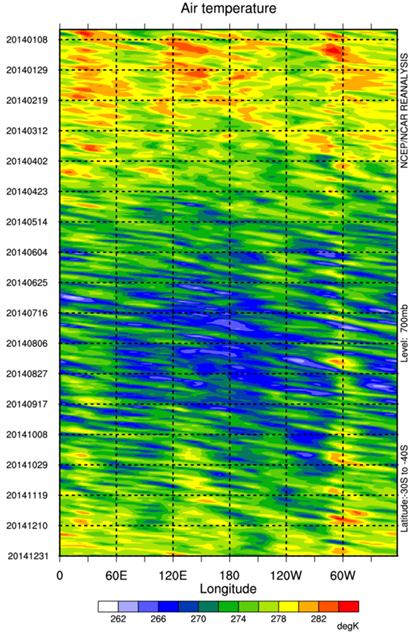
At 700 Mb (above) there is a a thicker, broader structure in the pattern of temperature variability in summer and thinner more linear elements in winter. This indicates a faster air flow in winter. In summer and autumn the air is relatively still. There is more seasonal definition at 700 mb than at 2 metre elevation emphasising that the movement of the atmosphere is influential in creating seasonal contrasts. It is the movement of the atmosphere that defines the equator to pole temperature gradient. If the wind blows alternately from a warm place and then a cold place we call it an oscillation, such as the Arctic Oscillation or the Antarctic Oscillation.
There is a much stronger graininess in temperature at 700 Mb than at the surface emphasising the dependence of surface conditions on the state of the atmosphere as it varies on short time scales. The degree of graininess is different according to longitude with the appearance of persistent linear elements in winter that propagate south eastwards more strongly in some parts than others.
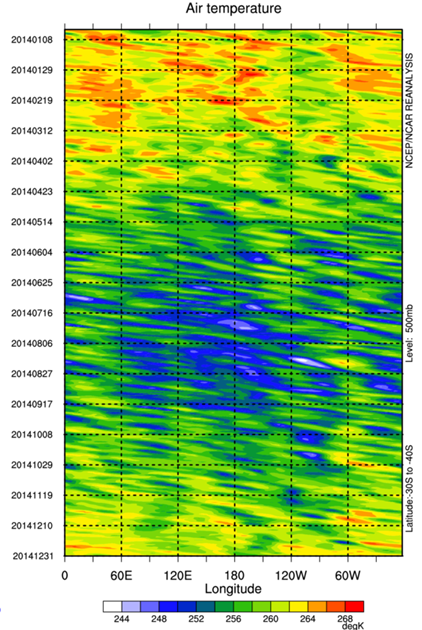
At 500 Mb (above) there is a similar pattern to that at 700 Mb but the winter season is shorter. In the vicinity of Africa the air is warmer across the year . This likely represents a consistent flow of warm tropical air southwards in that vicinity.
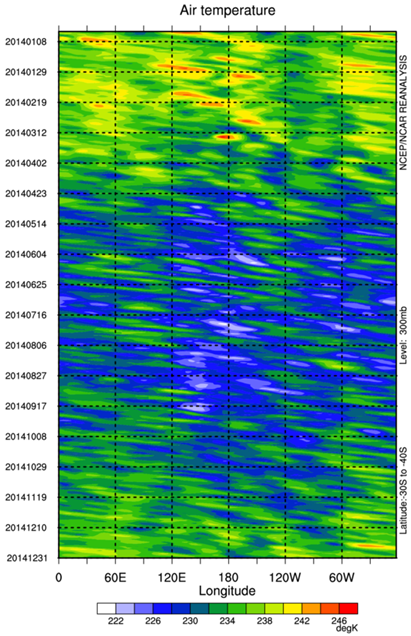
At 300 Mb there appears to be a marked extension of the winter season and reduced contrast between the seasons.
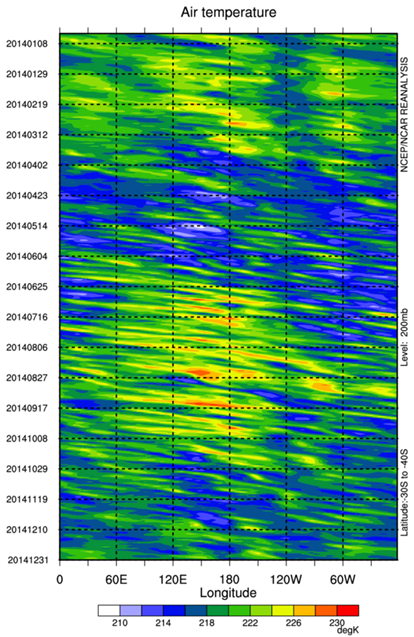
At 200 Mb (above) we see that the months June to October are warmer than the summer months. In particular this is the case between longitudes 60° East and 120° West. This relates to the pattern of the increase in atmospheric ozone in winter. We have entered a realm in the upper troposphere where the temperature of the air is markedly influenced by the presence of ozone. There can be no active photolysis of any atmospheric gas at the 200 mb to drive the warming of the air. Rather, heating is due to energy gain from infrared radiation that is emanating from the Earth itself. The ozone molecule absorbs at 9-10 um. This is a phenomenon unrecognised and unremarked in climate science even though ozone is recognised as a ‘greenhouse gas? The 200 mb pressure level is the altitude where jet streams manifest. Each small yellow-orange streak in the diagram above represents a stream of ozone warmed air that is rapidly ascending. There is a strong linearity and persistence in the patterns in this diagram. The pattern is quite different to that seen at lower altitudes. The difference relates to the marked change in density differentials between different air masses. Notice the concentration of warming between longitudes 120-180° East. due to the tendency of ozone to accumulate in low pressure cells in the southern ocean to the south of Australia and New Zealand. This is verified in the diagrams below that represent ozone at 1 hPa on the 16th day of the month, each diagram a month apart.
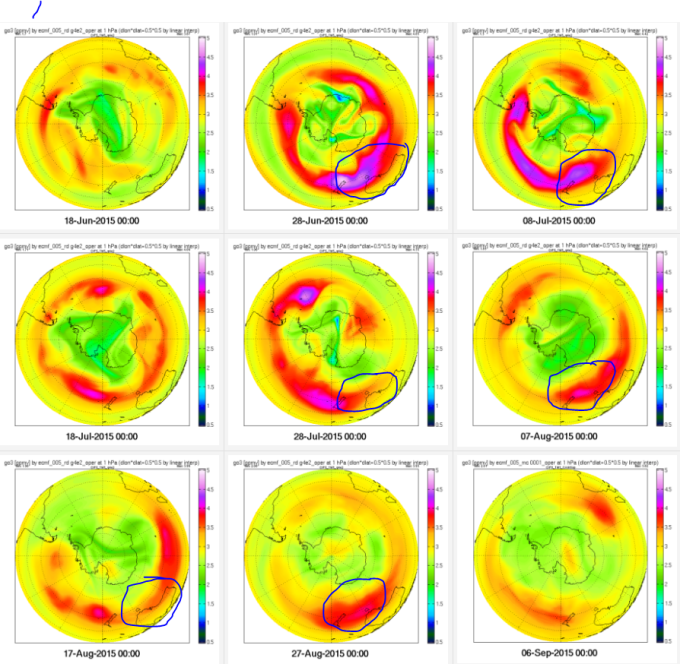
Above we have a polar stereographic view of Antarctica at the 1 hPa pressure level. These diagrams show the manner of the descent of ozone deficient mesospheric air over the pole and also the episodic tendency for ozone to accumulate over the Southern Ocean south of Australia and New Zealand at longitude 120 to 180° east of the Greenwich meridian. This tendency is reflected in the hovmoller diagrams both above and below. The heating process due to the increase in ozone partial pressure in winter delivers an even stronger contrast at the 100 Mb pressure level. In fact the 100 Mb pressure level is where the movement of the bulk of the atmosphere is determined. The temperature of the air and its movement has little to do with surface conditions and a lot to do with the ozone content of the atmosphere that increases strongly in winter.

The diagram above shows air temperature at 100 mb. Winter is warmer than summer at 100 hPa due to ozone heating of the air. The air is warmest in the Australia New Zealand sector due to the tendency for ozone to proliferate over the warm waters of the western Pacific Ocean that tend to promote the formation of zones of low surface pressure.
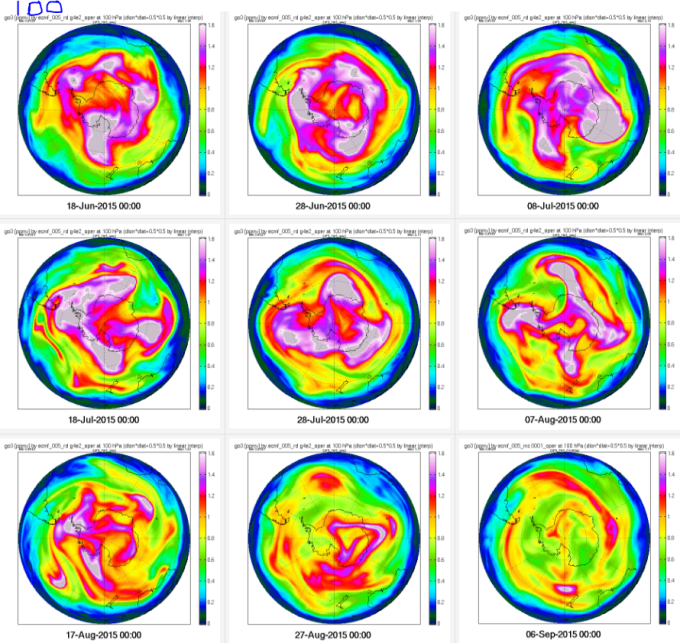
Above we see the distribution of ozone at 100 hPa over the southern hemisphere in winter. At this elevation the atmosphere shows the texture that would might expect at the interface of two different fluids moving at a slightly different rate but in the same anticlockwise direction. Tracers of ozone rich air emanate from nodes rich in ozone and are left behind in air that moves less rapidly. The nodes of ozone rich air tend to form in the lee of the continents where the waters are warmer and in particular in the Australian, New Zealand western Pacific sector.
The anticlockwise circulation of the air moves faster than the Earth itself and faster in the polar regions than at the equator. This gives rise to some very interesting questions: Is the force that causes the Earth to rotate on its axis also responsible for the faster rotating atmosphere, a disengaged fluid element that is free to reflect the forces of the interplanetary environment acting on the atmosphere? Are these forces responsible for the minute variations that are observed in the Length of the Day that are seen to be related to changes in climate as we measure it at the surface of the Earth? Is this rotation of the Earth and its atmosphere driven by the same sort of force that drives an electric motor. Does the atmosphere simply exhibit an amplified variation of the length of day type that could be measured in terms of the speed and direction of the high altitude winds. Does the rotation of the air speed up and slow down as the electromagnetic field changes under the influence of the sun and the solar wind?
Notice the generalised depletion of ozone that starts in August. This is due to the activity of NOx reaching the pole as surface pressure rises, the flow of mesospheric air is cut off and the final warming begins. In springtime as atmospheric pressure falls over Antarctica the stratosphere over the pole warms, the circulation of the air slows and by December it actually reverses its rotation at the 10 Mb level.
In particular we should be interested in whether the zonal wind slows as the stratosphere heats, not only on the annual scale, but also on the synoptic scale of days and weeks. If it does, perhaps the atmosphere is responding to the electromagnetic environment of which it is part.
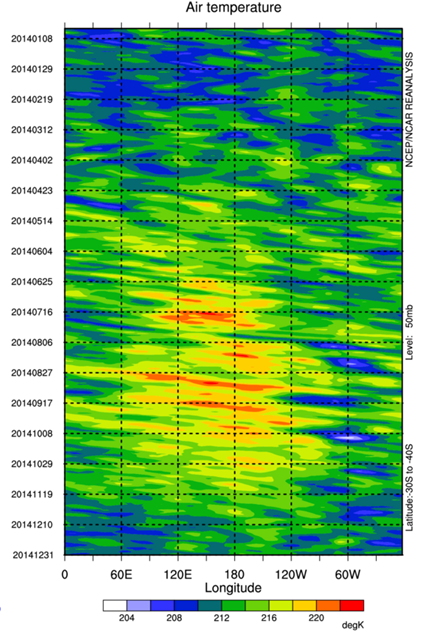
At 50 hPa (above) the pattern of ozone accumulation in the Australian New Zealand sector is more clearly defined. The pattern is less episodic, more linear and persistent. In fact the movement of the air even at 30° -40° south begins to reflect the linearity and the stop-go nature of the high altitude zonal wind that reaches its apogee in the structure of the polar vortex.Notice the difference in linearity between summer and winter. Notice the extension of winter warming until November that is the transition month between winter and summer conditions at this latitude. We are here looking at part of the driver for surface conditions in the southern hemisphere and indeed globally on all time scales.In a later chapter we will see that November is the ‘snap to attention’ month when the dominant role of driving the ozone content of the air is passed over short time intervals is passed, baton like, to the Arctic.
There is one other thing worth noticing. Its actually extremely important because it confounds what we read in Climate Science texts. The 50 hPa pressure level is in the lower stratosphere at an elevation of 20 km. The stratosphere is supposedly stratified, non convective and irrelevant so far as surface weather is concerned. In fact the stratosphere in winter is a very active part of the atmosphere in terms of air temperature, density and wind. Inspect the scale on this diagram. The range required to represent the data at 50 Mb is 22°C. At 100 hPa the range is 30°C. At 500 hPa the range required is 28°C, at 700 hPa 26°C and at 2 metres 40° C. What does that tell us about the forces responsible for the movement of the atmosphere? The atmosphere is a medium that tends to minimise temperature differences in the horizontal plane. The range at 100 Mb, though flattened by winter warming, indicates that the forces that are involved in generating air temperature and density contrasts aloft are more influential in driving the movement of the air than the forces that are active at the surface. The range required at 100 Mb is diminished by the reversal of the temperature relationship between summer and winter, a range reducing phenomenon that acts to conceal rather than reveal the forces at work . Perhaps a superior proxy for the strength of the disparities in density at 100 Mb is wind strength. Wind strength is least at the surface and increases with elevation peaking at Jet Stream altitudes. The inevitable conclusion is that the movement of the bulk of the atmosphere at 30-40° south latitude is driven at the 100 hPa pressure level or thereabouts by differences in the partial pressure of ozone as it effects atmospheric temperature and density.
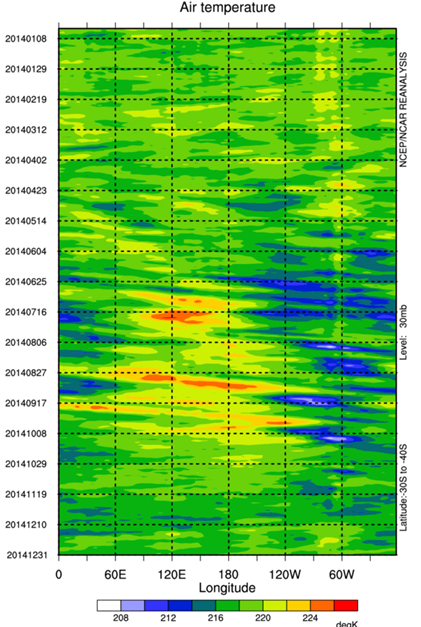
Above we see air temperature at the 30 Mb pressure level.The difference between summer and winter is greatly reduced. The range of variation is still greater in winter than summer. Only in winter do we see the characteristic north west to south east flow of the winter stratosphere. The patterns that are generated indicate strong variations in the temperature and density of the air related to the changing composition of the air itself. However, it appears that this is a zone where air tends to either descend or ascend (blobs rather than streaks) rather than travel laterally except in the winter where the circulation is more typical of that which prevails all the way to the surface.
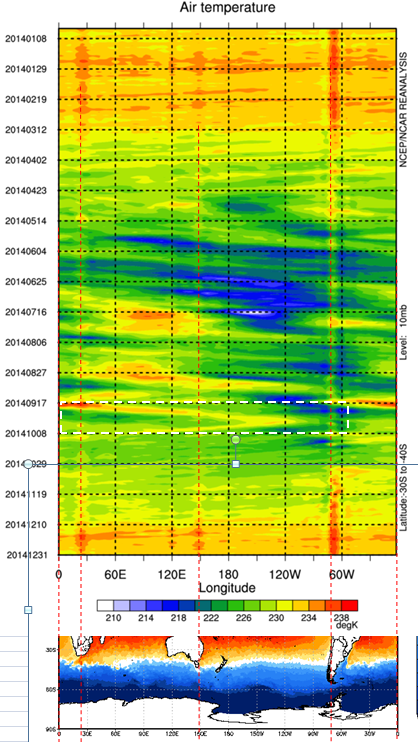
At the 10 hPa pressure level (above) the air is comparatively still. Only the strongest elements of the ozone driven winter circulation show up. Notice the south west to north east drift in summer as ozone rich air travels towards the zone of high surface pressure in the mid latitudes. The flow is north west to south east in winter. Here the temperature of the air relates to surface temperature in a manner that is not evident between 700 mb and 30 mb. The winter is cold and the summer warm as we would expect it to be. The land masses are especially warm. So, most surprisingly we see the signature of surface temperature at 10 hPa, an elevation where 99% of the mass of the atmosphere lies beneath.The warmth of the air plainly relates to the interception of infrared radiation by ozone. Because the air is relatively still at this altitude the pattern of long wave emission from the surface shows up. If short wave radiation from the sun were a big influence on the ozone content and the temperature of the air at this altitude this pattern would be obliterated in daylight hours. We cant tell from this diagram whether this happens or not.
There could be no better demonstration of the response of the stratosphere to the infrared radiation emitted by the Earth than this phenomenon. We see it because the air is relatively still. The temperature of the ozonosphere that stretches from the surface through to the mesopause is set, not by ionising radiation from the sun but radiation from the Earth itself. There is little variation in the ozone content of the air or its temperature at 10 mb that we can link to the tenfold variation in EUV across the solar cycle. Plainly, it is incorrect to maintain that the temperature of the stratosphere is a function of ionisation by short wave radiation from the sun. This statement, to be found universally in climate texts and the works of the UNIPCC and in Wikipedia does not square with observation.
We must look for other modes of causation for the potent variations in the ozone content of the air in winter than variations in the quantum of short wave energy from the sun. Indeed, only one percent of the air above 80 km in elevation, the zone called the ‘ionosphere’, is actually ionised. This zone contains less than 1% of the mass of the atmosphere. There is no problem in supply and no problem in persistence of ozone below the 10 Mb pressure level. The ozone content of the atmosphere is relatively invariable and seems to be assured, but not so at the poles in winter where we see big variations in ozone partial pressure from year to year.
If we look for zones where atmospheric dynamics involve a dilution of the ozone content of the air that can account for the paucity of ozone over the polar caps, the marked variations in the ozone content of the air from week to week and year to year and the relative paucity of ozone in the southern hemisphere in general we need look no further than the polar vortex in the winter season.
THE ZONAL WIND
The zonal wind is that which is measured as rate of travel a along a line of latitude and is called the ‘u’ wind while the meridional wind is that measured along a line of longitude and is designated as the ‘v’ wind. At a point on the Earths surface a wind can be described in terms of both u and v. It is weak in both u and v it is probably descending or ascending.
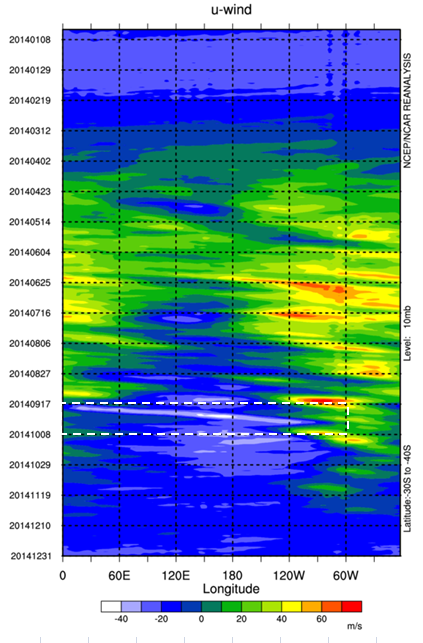
If we inspect the last several diagrams they all indicate a strong stream of warm air travelling around the globe in a south easterly direction after 2014-09-17. The timing of this warming air flow is associated with a collapse of the ‘u’ component, a symptom of warming over the polar cap associated with an increase in the ozone content of the air that is further associated with a collapse of surface pressure over the pole. This is a taste of that which happens in the transition between winter and summer. It is also closely associated with the appearance of the ozone hole over Antarctica when NOx rich air of tropical origin circles in to occupy the entirety of the polar cap between 100 hPa and 50 hPa.
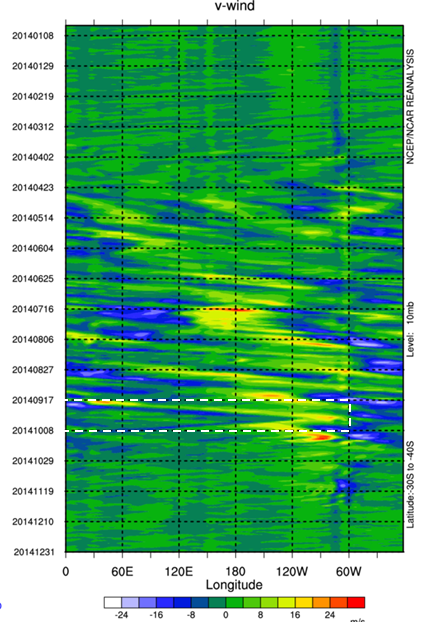
As we see above the ‘v’ component of the wind at 10 Mb is seasonally the mirror image of the ‘u’ wind. The meridional component falls away as the zonal wind component increases and vice versa.This is true on a seasonal as well as an episodic short term basis.
It is apparent that the movements of the atmosphere are tied to the partial pressure of ozone in the stratosphere. This is readily apparent when we study the movement of the air over the polar cap at 200 Mb as represented below. The first diagram shows the distribution of ozone over the Arctic on the 18th June 2016 as shown here. The second diagram shows the temperature of the air and its circulation over the Arctic on the 18th June 2016 as shown here. The third diagram simply shows the speed of the wind and locates the jet streams in relation to the distribution of ozone.
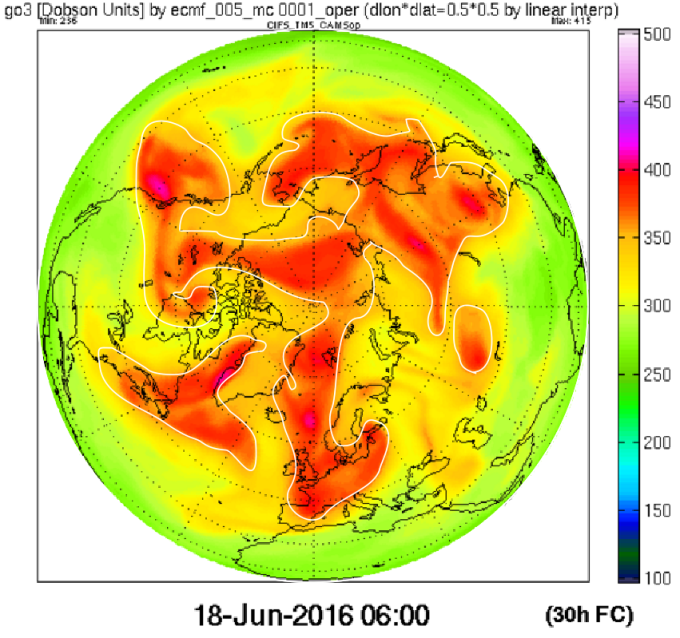
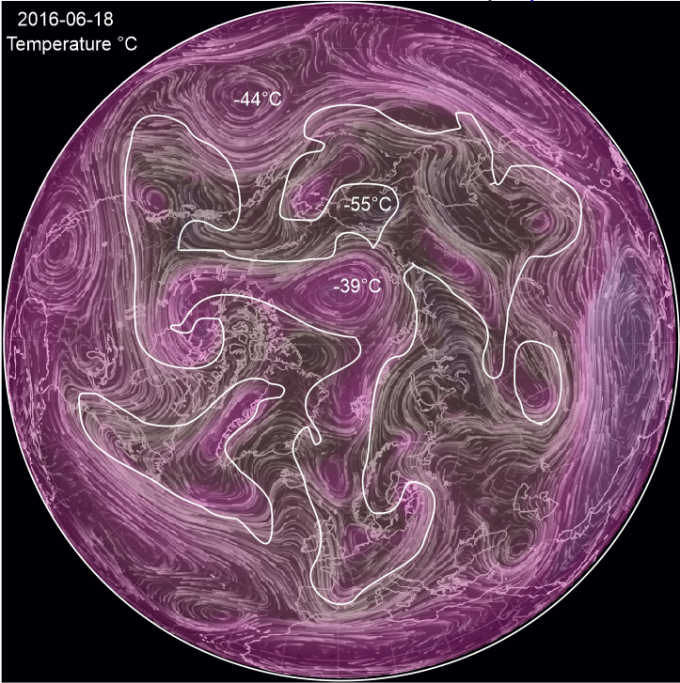
There is a core of cold air over the Antarctic within which pockets of ozone rich air are almost 20° C warmer. The conjunction of the two gives rise to the jet streams as we see below.
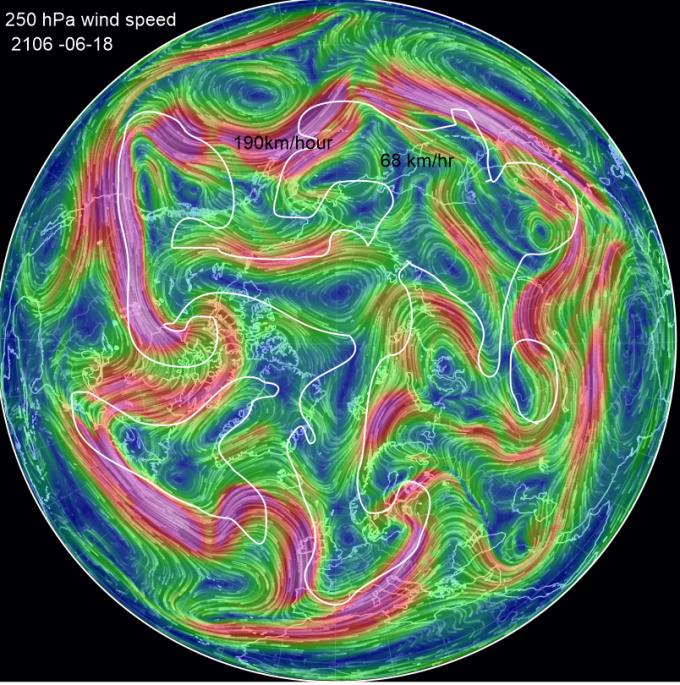
CONCLUSION
- The movement of the air is intimately associated with contrasts in ozone density. Speed of movement is greatest at jet stream altitudes where contrasts in air temperature and density are most extreme.
- Change in the intensity of the zonal wind that is associated with warming and cooling at the surface occur in response to the impact of ozone on atmospheric motions. In the northern hemisphere this phenomenon can be expressed in terms of the Arctic Oscillation, the North Atlantic Oscillation or the Northern Annular mode.In the southern hemisphere we talk of the Southern Annular mode. These are all recognised as prime modes of climate variation on annual and inter-decadal time scales. Climate science has no rationale for any of them and is unable to differentiate between climate change due to these entirely natural phenomena and that supposedly due to the activities of man.
- Climate change is associated with change in the ozone content of the air that drives the intensity of polar cyclone activity, shifts in atmospheric mass, change in the zonal wind and the equator to pole temperature gradient.
- Winter is the season where weather variability is greatest and this is clearly associated with change in the ozone content of the air. This is backed up by the observation that across all latitudes the month of greatest variability in surface temperature is either January or July as described here.
- The circulation of the atmosphere is not driven from the equator but from the winter pole. There is evidence that the ozone content of the air at the poles depends upon solar activity via several different modes.
Unless we can separate out and properly account for the change in climate that is due to the fluctuating ozone content of the air we are in no position to quantify the change that many attribute to the works of man. Green activists are clearly ‘jumping the gun’. When we come to look at the manner in which the climate changes according to latitude it will be plain that all change, I repeat ALL change, is very likely attributable to natural modes of causation rather than the works of man and we will be able to say, ‘hand on heart’, or on a ‘stack of bibles’ and ‘with a very high level of confidence’ that we are speaking the truth.
Although this paper by Sheppard, rabbits on about modelling, fig3 is interesting. http://www.tandfonline.com/doi/abs/10.3137/ao.460106
However, I am thinking that the distribution of ozone throughout the atmosphere is not determined by how ozone gas is circulated, but how the physical and chemical conditions that influence the Chapman cycle change in location and time. the excellent graphics show the amount of total column ozone above any point on Earth changes constantly on a time scale of minutes. Newman claimed in a 2013 paper the Sun (UV)produces about 12% of the ozone layer each day.!!!! We also see 1360W/m2 coming in and 340W/m2 going out and that outgoing heat is lost as per lapse rate until the tropopause. So why cant we then say the greenhouse/ozone “blanket” is ultimately provided from above, not below.
LikeLike
Hi Macha This little footnote is revealing:
† Strictly speaking, when speaking of the chemical lifetime (or, for that matter, transport) of ozone in the stratospheric context, what is really meant is the chemical lifetime (or transport) of odd oxygen, as ozone rapidly recycles within the odd oxygen family but this involves no net loss or gain of ozone (McConnell, this issue). However, the more common (if strictly incorrect) usage is retained in this article.
Odd oxygen can not exist without a constant pressure of ionisation. That is where the the thesis falls off a cliff straight away. The globe is spherical, it presents a slightly different face to the sun each day as it rotates about it. The radiation falls like the rays of a torch and has its greatest impact in the vertical. Outside the cone of impact and below about 50km in elevation there is very little ionising radiation to be had that will give rise to those odd oxygen species. The control is then strictly according to the rate of ionisation of the ozone molecule itself and the processes of chemical depletion. That is path length dependent and it represents a one way process for depletion. Where then does the ozone come from that drives atmospheric dynamics in the winter hemisphere? Certainly not from Chapman cycle dynamics requiring energy from UV.
The ozone that proliferates below the mesopause is a by-product of the ionisation of oxygen that is most active above 80 km in elevation with severely truncated level of activity below that level. To the extent that ozone molecules can form, and it is only becomes possible below the level of active ionisation (80km) the lower the elevation, the longer their life will before before they are in turn ionised. Fortunately, ionisation is limited to that aforesaid cone of activity. Elsewhere, including perhaps 90 percent of the mass of the atmosphere it has a safe refuge from ionising short wave radiation. So, both vertical and horizontal movement is vital. That ozone molecule must get on the train to higher latitudes or lower altitudes. Once there, its safe, but not from the processes of chemical erosion. The most aggressive mode of chemical erosion is below the tropopause. In fact NOx creates the tropopause by sculpting its form from beneath. In the same fashion it sculpts out the ozone hole during the final warming, much more effectively in the Antarctic than the Arctic…..a matter of geography that determines the circulation of the air.
Chapman cycle: 1930s thinking. The pre-satellite age. No idea of the circulation of the atmosphere, very little knowledge of the upper atmosphere or where ionisation occurred. Dobson developed his instrument concurrently, only widely used in the 1950s. First instrument gets to Halley Bay in Antarctica 1956. Brewer Dobson Cycle represents Brewer in the 1950s guessing why ozone partial pressure increases in higher latitudes…..positing transport. In fact at 10 hPa the movement of the air is from the poles towards the equator so he has it arse about.
People get their learning from books. They quote authorities. Dobson was the last great observer in this field of activity. He was followed by people who came to be selected not on the basis of their curiosity and ingenuity in measuring and observing phenomena but according to their ability to parrot the ideas of the gatekeepers.
The ozone ‘blanket’ must be distinguished from a ‘greenhouse blanket’. Neither, in the circumstances where the atmosphere is thin and violently convective (all of it) are capable of heating the air below the point at which they absorb energy. The energy they absorb is from infrared (from the Earth). Not ultraviolet that is as rare as hens teeth in 90% of the volume of the atmosphere. The heating effect is strictly local. It reduces atmospheric density and results in wind. The strongest winds occur when density gradients are most severe, between the 300 hPa pressure level and 50 hPa except in the winter hemisphere where they are associated with the polar vortex. These winds drive the circulation of the atmosphere and their nature changes according to changes in the partial pressure of ozone. CO2, that is uniformly distributed has nothing to do with it.
So, Shepphard says: ‘In the upper stratosphere (outside of polar night), the chemical lifetime of ozone† is much shorter than transport time scales, the latter being on the order of weeks. It follows that
ozone is under photochemical control and transport of ozone has little impact on ozone abundance (see McConnell, this issue).’ This is fairyland stuff.
He also says: ‘Below about 30 km (and during polar night), the lifetime of ozone is comparable to, or longer than, transport time scales and ozone is strongly affected by transport. Because most ozone is found in the
lower stratosphere, the column ozone distribution largely reflects the distribution in the lower stratosphere and exhibits a significant asymmetry between the hemispheres, maximizing in the winter-spring seasons (Fig. 2 of Fioletov (this issue)). This asymmetry arises because of dynamics and is well understood.’
Only to be well understood if he explains why. The stuff about planetary waves is pure fairyland.
But there is some truth in this statement: ‘Although transport in itself cannot change ozone abundance, the rapid chemical replenishment of ozone in the upper stratosphere together with the poleward transport
implies a net increase in extratropical column ozone during the winter-spring season.’ Hmmmm. Correct. Transport can not increase abundance. So, he hasn’t really explained how ozone partial pressure increases in high latitudes at all.
The explanation for the difference in the ozone content of the two hemispheres is wide of the mark.
At this point I skipped. There is insufficient understanding of the processes involved in determining ozone abundance. There is no evidence of any understanding of the processes that determine the circulation of the air. The notions as to the cause of the ozone hole in Antarctica are a result of the aforementioned circumstances. I would have no confidence that a model built on the foundations explained in this paper would be a useful tool.
I did read the conclusion. Not impressed.
LikeLike
So true about quoting from others. Knowledge gained leads to formation of beliefs, which in turn guide our thinking and ultimately actions. Truely science could do with more observational evidence to support theory and as Einstein said, it only takes once to prove wrong. You are one of the few….i suspect that because government is locked into universities that too many scientists are hand_cuffed to careers and any future earnings conditional on predetermined outcomes. Right or wrong in his concept , SALBY seems to have suffered and others don’t want to take the risk. Same goes for IPCC or U/EU bureaucrats gravy train- dont want to lose a good wicket. in reference to last links, you make good points, hiphip for nullschoolearth etc. Look, I recognise there is IR warming of air from earth. The key is the amount it imparts to each characteristic wavelength. The interesting difference ozone has from other non-phase change gases is its lack of uniformity or is it not alone….NOx, SOx, Cl…. So what “fence” or molecular seive exists to screen out one gas from another in a particular parcel of air.? The ozone concentration we see does not tell us much about the balance between the vast quantity simultaneously being generated and destroyed. but it is that very imbalance that produces correlations with temperature and its that whole parcel of air is at that temperature. Also, temperatue at 20kms up is hardly stuff we experience at surface/ground and wouldn’t that be where most reflected IR is absorbed.
LikeLike
This has NASAs take on the chemistry…and if nothing else, useful for me to get my terminology consistent and coherent. I beleive I am catching up..
.http://www.ccpo.odu.edu/~lizsmith/SEES/ozone/oz_class.htm
LikeLike
So what “fence” or molecular seive exists to screen out one gas from another in a particular parcel of air.? No, it doesn’t work like that. NOx is generated at the surface of the Earth on land in the mid land low latitudes mainly in summer and spreads via the winds, diffusion and convection. Ozone is enabled by the ionisation of oxygen and that’s also location and time specific. It accumulates according to the incidence of destructive UVB to which it is susceptible as a very large molecule. So, it accumulates in high latitudes where NOx pressure from surface generation is light. and it is relatively free from ionisation by UVB. There may be ozone production enabled via cosmic ray activity. There is also the dilution effect from the downdraft of mesospheric air.
The main thing that gives rise to air movements is surface pressure differences…..due to ozone. Once the air starts moving from areas where the tropopause is high (and surface pressure also high) towards areas where surface pressure is low and the tropopause is low you have very different parcels of air coming together. One must rise. The direction of rotation that is in the same direction of the Earth but faster, and fastest at the highest altitudes directly over the pole is probably under electromagnetic control.
When you talk of ‘reflected IR’ it bothers me. In my view its absorbed at the surface along with shorter wave lengths where most of the energy is, heating in the process, and the body that warms re-radiates. Now, infrared is infrared whether it comes from the sun or the Earth and it will excite ozone regardless of its source. But, the dominant source of infrared is the Earth because it doesn’t radiate short or very long waves. It radiates day and night. And in higher latitudes the ratio between whats going out and whats coming in is very high.
LikeLike
” Is the force that causes the Earth to rotate on its axis also responsible for the
faster rotating atmosphere, a disengaged fluid element that is free to reflect the
forces of the interplanetary environment acting on the atmosphere? Are these
forces responsible for the minute variations that are observed in the Length of
the Day that are seen to be related to changes in climate as we measure it at
the surface of the Earth? Is this rotation of the Earth and its atmosphere driven
by the same sort of force that drives an electric motor. Does the atmosphere
simply exhibit an amplified variation of the length of day type that could be
measured in terms of the speed and direction of the high altitude winds. Does
the rotation of the air speed up and slow down as the electromagnetic field
changes under the influence of the sun and the solar wind? ”
Hi Erl, and all great questions.
After watching this video, I’ve been a follower of Dr Vincent Courtillot. He’s a
solid earth geophysicist who has done a lot of work with geomagnetic jerks
and LOD (at the 20 min mark). There’s also a great section on the electrically
charged atmosphere (at the 25 min mark).
2011 video link:
Youtube Prof. Dr. Vincent Courtillot, IPGP
youtube.com/watch?V=IG_7zK8ODGA
paper:
Courtillot, V., Le Mouel, J.-L., 1988. The time variations of the Earth’s magnetic
. . field: from daily to secular. Annual Reviews Earth Planetary Science 16, 389-476.
In this 1988 review, Courtillot and Le Mouel examine the geomagnetic jerk of 1969.
This 1969 geomagnetic event occurred precisely at the start of a new Jose Cycle
(an ~179 year solar motion cycle). You can see my graphs at
Weathercycles.wordpress.com
Also, Ian Wilson has found a LOD connection with a major lunar cycle.
Astroclimateconnection.blogspot.com.au
LikeLike
TL Mango,
Courtillot is very impressive. He comes across as a man who is straight down the line, very good thinker, very good at articulating an argument and holding his audience’s attention. His point about observation being the key element of problem solving behaviour is fundamental. Mathematicians are great at constructing models but the last thing they seem to want to do is to get their hands dirty. Just a moments attention to the manner in which the Earth warms according to latitude and time and the observer (never a mathematician) will completely discard the ‘climate forcing’ argument and start looking for modes of causation that operate in winter in high latitudes. If you don’t observe you are out playing with the fairies.
Coutillot adopts the regional approach and finds the time signatures relating to modes of change. That is my approach also. Do you have links to his papers?
LikeLike
Got it: http://www.pensee-unique.fr/courtillot3.pdf
LikeLike
Hi Erl, here’s the link:
” Time variations of the Earth’s magnetic field ”
researchgate.net/publication/229086821_Time_Variations_of_the_
Earth%27s_Magnetic_Field_From_Daily_to_Secular
5.1 The 1969.5 secular variation impulse (jerk) . . . . . . . Page 416
LikeLike
Here’s some more on atmospheric electricity
” Effects of global circuit downward current flow on atmospheric
dynamics: modeling of relevant cloud micro-physics ”
XV International Conference on Atmospheric Electricity
15-20 June 2014, Norman Oklahoma
nssl.noaa.gov/users/mansell/icae2014/preprints/Tinsley_282.pdf
LikeLike
I am looking for a more solid link between atmospheric temp drivers you refer to and those at more closely at the surface. After all we mostly live on land not at altitude. I cant reconcile (low) heat capacity of air versus the oceans, and ability of water to convect (huge Cp) with winds. We see temps fall with lapse rate all the way up to ozone layer. In this context, does your definition of “climate change” relate to the air space above (say) 10-15kms, or below- where we will live/feel it, or the whole Column? Basically, assuming you are spot on, how dominant is the ozone effect on us versus the lower level domination of Gravity/ pressure driven effects. Ie always hottest at surface – which is, in my view, dominated by changes UV heating not IR.
LikeLike
Macha,
What I seek to explain is the surface conditions. The Earth is a sphere. Its hot in the torrid zone and cold in the frigid zone. The space between is alternately one way or the other depending upon which way the wind is blowing. I seek to explain the origin of change in the planetary winds. Shits in atmospheric mass change the planetary winds.
Secondly, it so happens that as mass shifts from poles to other latitudes driven by polar cyclone intensification the ozone that ascends in the mid to high latitudes descends in the mid latitude highs changing cloud cover and incident radiation at the surface. That has the potential to warm the oceans and change temperatures throughout.
In general terms surface temperature is a matter of insolation conditioned by albedo and re distributive effects managed by the atmosphere and the ocean currents.
LikeLike
Thanks and a pretty substational goal too. Then lets now let the ride continu, because some other sites seem to be stuck in one gear lately. I really appraciate the time you have taken to help me get inside your head. I know i was a long way off the pace and these mechanisms are not easy to sort out in a coherent way. I hope I do not get in the way. cheers.
LikeLike
Also wondered if you seen the latest from reports Csiro. https://www.environment.gov.au/protection/ozone/publications/antarctic-ozone-hole-summary-reports
Animations of the daily images from the 2015 ozone hole (along with previous years’ holes) in various video formats can be downloaded from ftp://gaspublic:gaspublic@pftp.csiro.au/pub/ozone_hole/. . Apparently…
LikeLike
I would sack the whole crew. On their last day I would send them home with this to read: https://reality348.wordpress.com/2016/05/14/23-the-dearly-beloved-antarctic-ozone-hole-a-function-of-atmospheric-dynamics/
LikeLike
Never in the way Macha. Every question helps. Apart from that its a lonely task. Racing to finish now and do something else with my life. I am five drafts up on what you have seen. Beginning to pull the threads together.
LikeLike
RE: csiro. Agree on huge wasted opportunity. Ie $$$. I have Been duplicating your plots for myself and observing trends. Interesting from my work is to see relative humidity plots and wind speeds, versus temperatures and pressures. Sorry cant give graphics just now.. Looking forward to your next chapters.
LikeLike
Reblogged this on Climate Collections.
LikeLike